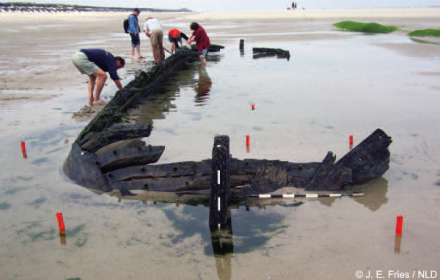History
According to a local legend, the wreck originated from the era of the Napoleonic Wars when French troops made a hasty retreat and embarked on coastal vessels. The wreck lies bottom up and has been addressed as one of the transport ships that could not escape her pursuers when it capsized.
Description
The wreck is situated in the tidal mudflats of the Pirolatal on the beach of the island of Langeoog. The hull shape indicates a flat-bottomed vessel with a rounded stern. A few floor-timbers with integrated limber-holes, top-timbers in parallel alignment to the latter, and massive stem- and sternposts were observed. The dendrochronological analysis of a sample taken from a floor-timber yielded a felling date of around/after 1798.

| Length | 61 ¾ feet (18.8 m) |
|---|---|
| Width | 12 ½ feet (3.8 m) |
Status
The wrecksite has been known for some time, but it was not until October 2012 when it was officially reported.
The responsible regional branch in Oldenburg of the Lower Saxony State Office for Monument Preservation (NLD: Niedersächsisches Landesamt für Denkmalpflege) carried out a survey in July 2013 before the wrecksite became subject to a beach nourishment measure, carried out by the State Agency for Water Management, and Coastal and Environmental Protection of Lower Saxony (NLWKN: Landesbetrieb für Wasserwirtschaft, Küsten- und Naturschutz). Local guides were instructed to notify the NLD in case the wreck becomes unearthed again.
In February 2016, a tidal creek has formed in close proximity to the wreck, becoming subject to further erosion and destruction. Most of the wreckage was reported missing in April.
The wrecksite was a local sightseeing attraction and the condition of the wreck was frequently reported in the local news.
References
- Fries, J. E. (2014).
Bericht der archäologischen Denkmalpflege 2013.
Oldenburger Jahrbuch 114.
pp 219-232. - Klaus Kremer (Langeoog News).
Pirolatal-Wrack ist Geschichte.